Lithops are a group of juicy plants that originated from Southern Arica. There are different types of lithops (about 140+ varieties) and they all look alike.
Lithops are also known as "living stones" because they blend with the stones around them so that animals do not eat them. Even though lithops naturally occur in the wild, gardeners can also cultivate them as houseplants.
Lithops live long. They can stay alive for 50 years. One benefit of using lithops as a house plant is the fact that it doesn't need much attending. Normal sunlight and occasional watering should be all you need to make it grow.
In this article, we will talk about the different lithops varieties, how to care for lithops plant, and also answer some of the most frequently asked questions about the living stone plant.
Table of Contents
Lithops Plant Overview
| Lithops Origin | South Africa, Botswana, Namibia |
| Scientific Name | Lithops spp. |
| Other Names | Lithops, living stone, split rock plant, pebble plant |
| Plant Type | Succulent |
| Family | Aizoaceae |
| Sun Exposure | Requires full sun with partial shade |
| Watering Requirements | Needs minimal watering |
| Toxicity | It's non-toxic to people and pets |
| Humidity | Tolerates humidity, prefers low humidity |
| Soil | Coarse, peat, garden soil, perlite |
| Spacing | Enough space when planting |
| Height | ½-1 long and 1-3 wide (depending on the species) |
11 Fun Facts About Lithops
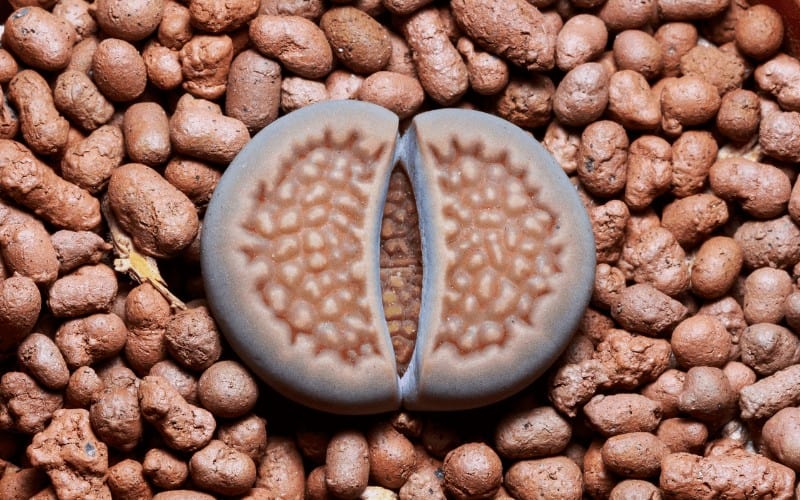
Below are some interesting facts about lithops plant that you may wish to know:
- Lithops were founded in 1811 by John Burchell when picked up from a stony ground
- Lithops are mostly found in very arid regions
- Lithops does not have a stem
- They are among the ACO ACI family that is made up of plants such as the “ice plant” and they somewhat resemble each other
- Lithops are often grown from seeds
- The living stone plant thrives best when kept in compactive sandy rocks, rocky soil that has little water or irrigation all through the year
- Lithops can live for up to 40–50 years, and it's common for someone to have their lithops plant in the same pot for up to 10-20 years
- Lithops seed can take up to one year to germinate
- Shade and overwatering will kill lithops plant
- Lithops plant grows new pair of leaves each year – and they only have one pair of leaves at a time as the old leaves will have to die for a new one to grow
- Lithops are non toxic to both humans and pets
Different Types of Lithops
Ever since William Burchell found and described the very first lithops in the year 1811, botanists have found and named over 40 other types of lithops. Here are some of them.
1. Lithops localis
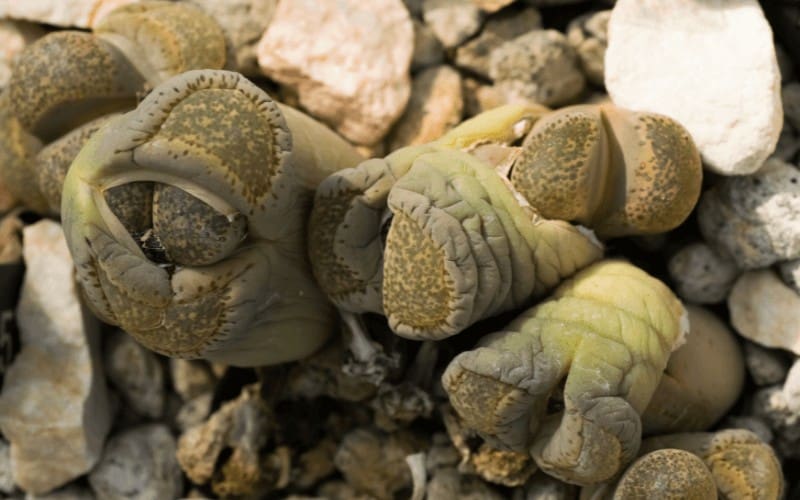
Botanists also call this Lithops terricolor. It is native to Southern Africa. Gardeners and interior decorators make use of this lithops. The former uses it as a house plant, while the latter use it for landscaping.
Whether you’d want to use it as a house plant or as a beautifying plant, ensure that you plant it in soil with good drainage.
Lithops locals are a special lithops in the sense that they can tolerate irregular watering. Hence it is quite easy to grow. Lithops localis is green-grey or grey with some green hue decorating the leaves’ flat top.
2. Lithops hookeri
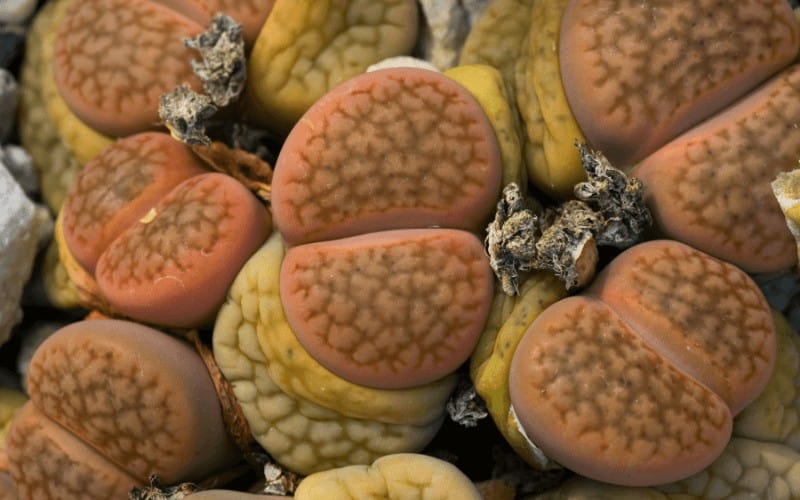
The lithops plant with the largest leaves. The leaves grow to 2 inches in width. Lithops hookeri’s leaves come in different colors.
You can find different colors of leaves on the same plant. Leaves on top of the plant could either have red or brown hues, they could also be orange or pink. The leave’s sides are gray or brown.
It has yellow flowers, and it grows a lot in South Africa. You will most likely find this type of lithops plant growing on quartz, lava rock, and limestones. These plants are quite common in Cape town.
3. Lithops Salicola
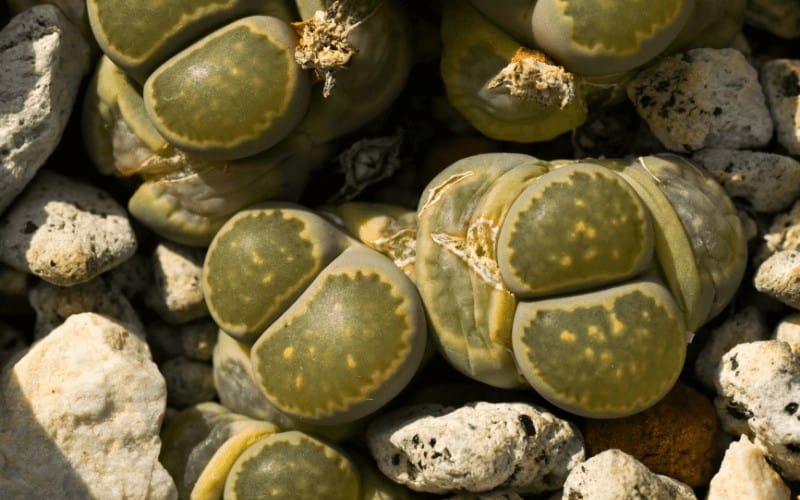
This is one type of lithops that produces some of the most ornamental flowers. It is quite a small species when you compare it with the sizes of other lithops. The plant’s flowers are white with yellow dots.
This is another easy plant to use as a house plant because it can stand cool weather to an extent. It can also withstand irregular watering. Lithops are widely abundant in Namibia and South Africa.
You will find the lithops salicola flowering during autumn. Because it prefers habitats rich in minerals, botanists call it the salt-dwelling living stone.
4. Lithops Optica
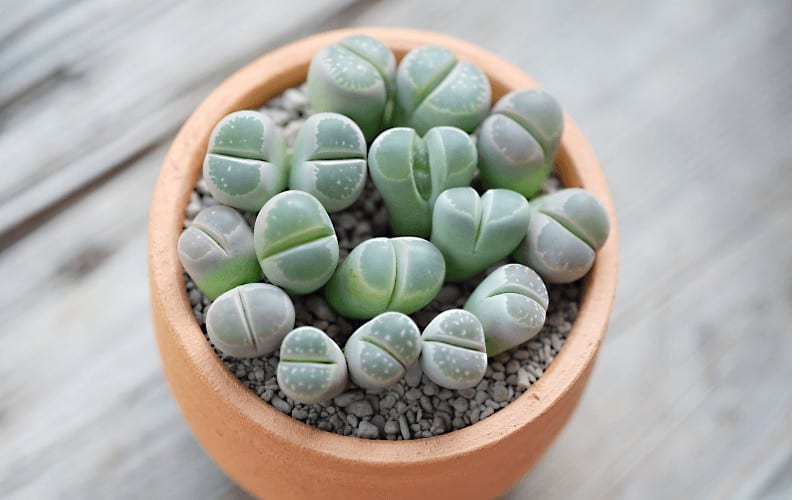
This lithops is one type of lithops that is nearing extinction. Lithops Optica got its name because it has a window on top of the lips that looks like an eye.
The plant just has two leaves that grow on top of the ground. The most popular lithops optica is the Rubra species.
It is bright red or purple. Like most lithops, it needs soil that has adequate drainage. A rule of thumb when cultivating lithops optica is to stop watering it after flowering has stopped. Flowering can continue when new flowers start growing.
5. Lithops Ruschiorum
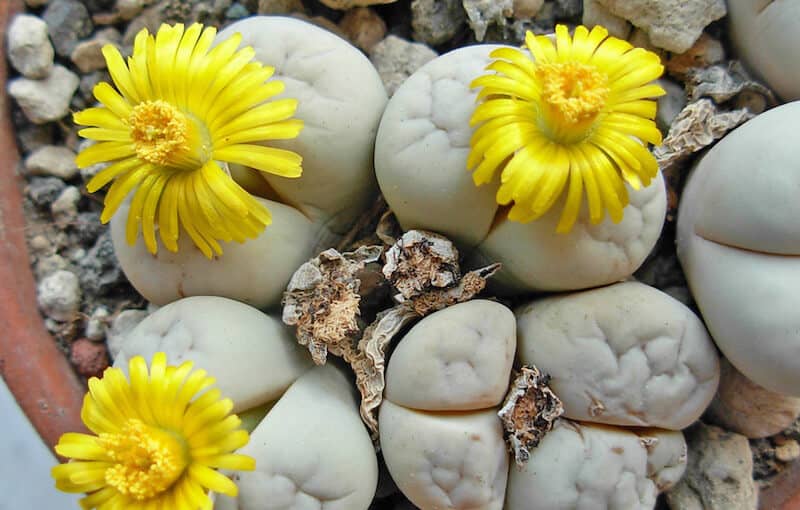
When you look at the lithops ruschiorum, you will see a natural marble. This is one of the lithops with the best camouflage. It comes in pale grey colors with tan or dark grey spots.
The flowers of lithops ruschiorum are yellow and you can easily find them in Namibian mountains and deserts. It grows either solitary or in clumps of 6 bodies.
Lithops ruschiorum unlike Lithops Optica is not at risk of extinction. Again, this type of lithops does not succumb easily to cold temperatures.
People also call it Hottentot’s buttocks or Bushman’s buttocks, and this is because the plant is like a buttock.
6. Lithops Aucampiae
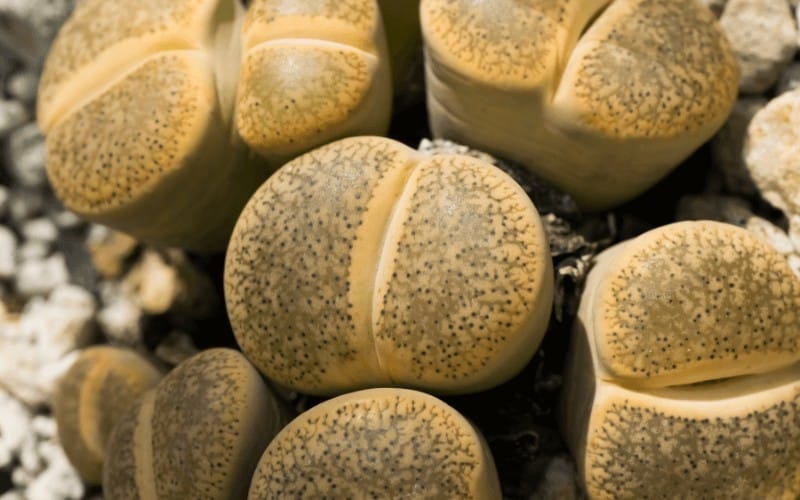
Juanita Aucamp was the woman that discovered Lithops Aucampiae at the Northern Cape of South Africa in the year 1929. Lithops Aucampie can endure overwatering, much more than any other type of lithops.
Still, it is wise not to test its limits as the plant might just die. Excess water will cause the leaves to burst.
The leaves of lithops Aucampie are brown or red, and the flowers come in different yellow shades.
It forms clusters ranging from two to 12, although the most common are from two to five. The leaves have a large window where sunlight penetrates the lower plant part.
7. Lithops Lesliei

Lithops Lesliei exists in Botswana. Lithops lesliei lives in its natural habitat, unlike other lithops. Lesliei species are unique because they come in a wide range of colors, from green to coffee, to red color.
It can camouflage so well and blend with the soil, and this makes it hard for animals to see it.
Again, it does not grow more than few millimeters off the ground, and this makes it even inconspicuous the more. Flowers on lithops lesliei are usually yellow, but you can see a white flower on it occasionally.
8. Lithops Viridis
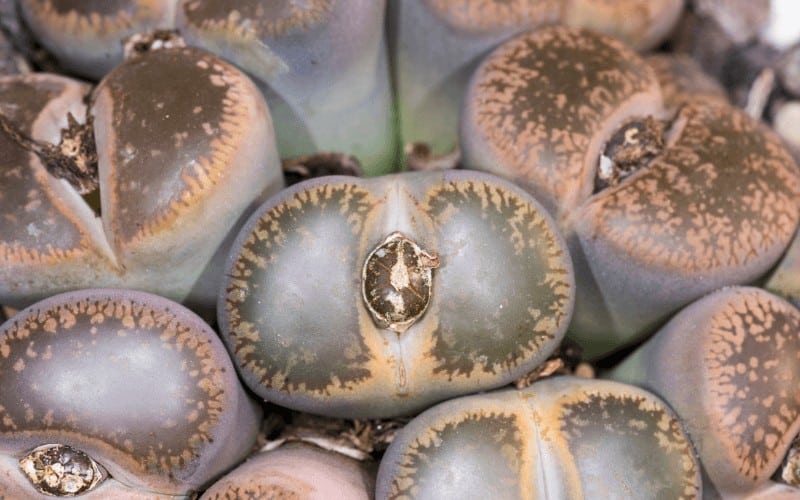
Ever heard of the name “green rock plant”? That is the common name for lithops Viridis. You find them in abundance in South Africa’s Northern Cape. This is one of those types of lithops that has an almost uniform color.
They usually green-gray and have pink hints at the edges. Its flowers are yellow, with some having a white core.
9. Lithops Verruculosa
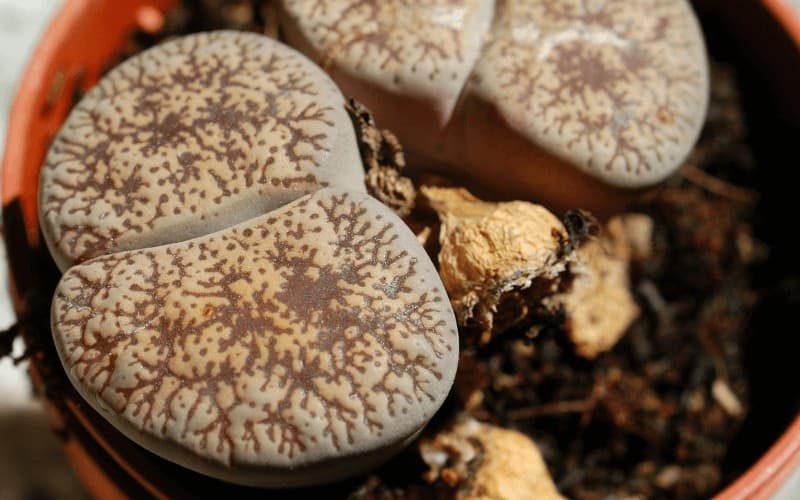
A warty living stone is another name for this plant. It grows 28mm long and 20mm wide and does well in granite soils among gravel and stones, its color is; bluish-grey, pinkish-grey, brownish.
It was first collected by Dr. Can Der Wethuizen in September 1939 in Bushmanland, Cape Province.
As described by Gert Cornelius Nel in 1947, it is a flowering plant in the genus lithops, verruculosa otherwise known as Rose of Texas is small with attractive pink flowers, it has a yearly cycle growth and can also grow fine in poor habitats.
10. Lithops Dinteri
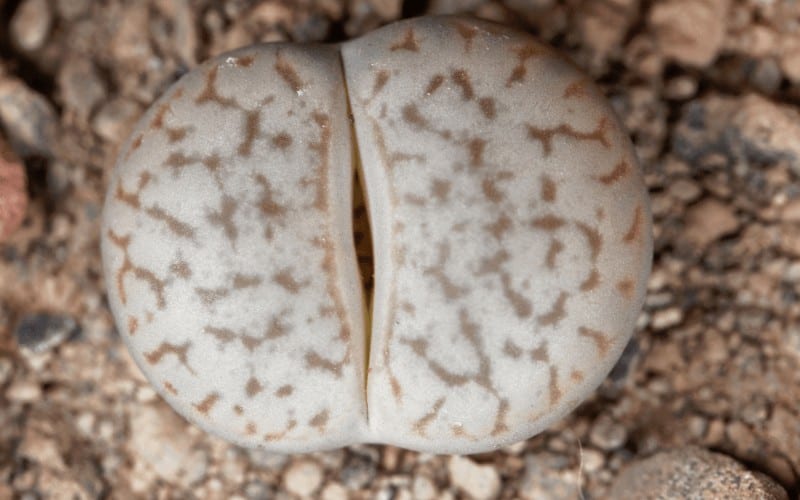
The Dinteri is mostly seen in Southern Africa though it was first found in Quartz in Wittsand, South Warmbad in North of Orange River by Ernst Rusch in 1926. The plant was described by Martin Heinrich G. Schwantes in 1927.
It is also called Dinter's living stone. Like most lithops, it is a flowing plant that breeds fleshy leaves. It also bears yellow flowers and it is quite a rare species.
It grows 22mm long and 15mm wide and forms clumps of 8 or more heads. They are light brownish-green. It has an extensive root system which makes it grow well in drained substrate and will require larger pots when planting.
11. Lithops Dorotheae
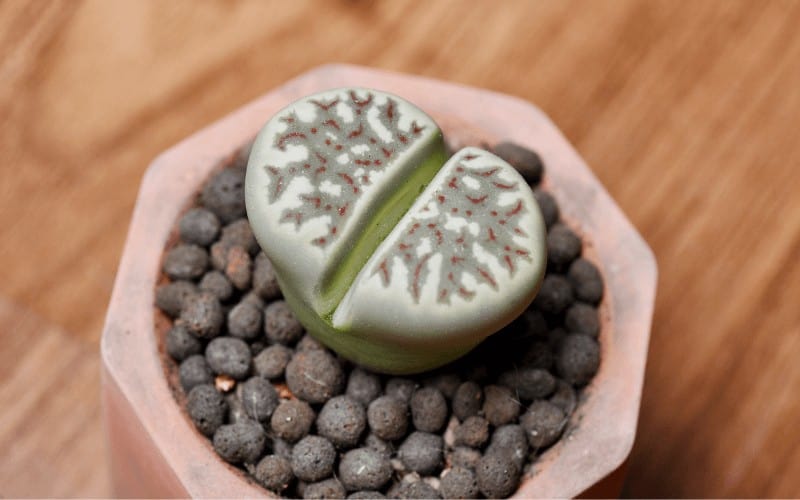
This type of lithops is found in South Africa, though it was described by Gert Cornelius Nel in 1939; it was attributed to Dr.Dorothea Van Hyssten who found it in 1935.
The body is yellowish-brown or light brownish-yellow with a grey-green window; red dot and lines. Dorotheae grows 30mm long and 20mm wide at the fissure, it rarely forms clumps of more than 2 heads. It appears in mid-fall.
It grows well in rock containing quartzite and it’s located near Pofadder, Bushmanland. During growth, its leaves emerge in the fall and grows through the winter and into summer.
Dorotheae is related to dinteri because they appear to be interfertile.
12. Lithops Bromfieldii

Bromfieldii was given in honor to a botanist William Arnold Bromefield, hence the name bromfieldii. It was found in South West of Upington near Orange River and was described by Harriet Margaret Louisa Bolus in 1934.
It is a medium-sized yellow plant – about 3.0cm long and 1.8cm wide at the fissure. It flourishes hidden under bushes or aloes and reaches its maximum growth in 2-5 years.
It is a faster clumper that can produce a large mound with more than 14 heads. Just like most of the plants it is stemless and would require a little bit of care to keep it going.
13. Lithops julii
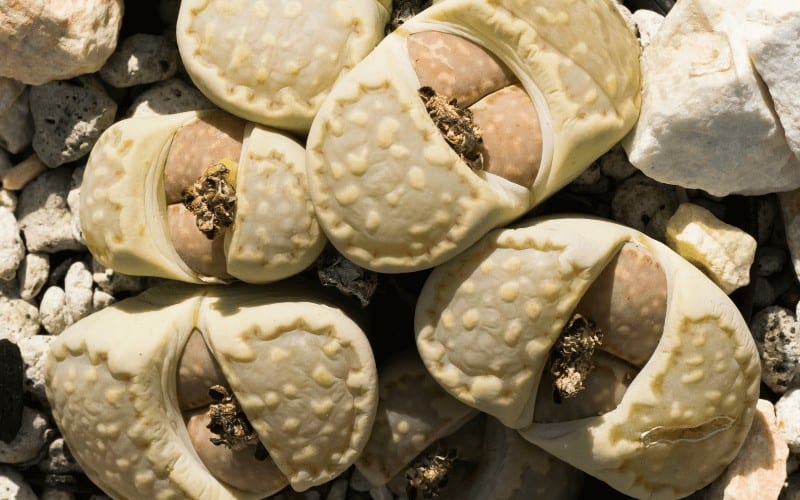
Julii like others is a small succulent with its cone-shaped body. It bears pinkish-grey, yellowish-brown, and grey leaves sometimes with marking usually brown. It grows well in rocks and isn’t attention demanding.
It was collected by Professor. K Dinter but named after Dr. Julius Derenberg of Hamburg. This plant grows up to 25mm long and 18mm wide at the fissure. It’s located Halfway between Vahldorn and Warmbad.
It has other varieties of lithops julii var.rouxii, some of it could be subspecies of fulleri.
14. Lithops Olivacea
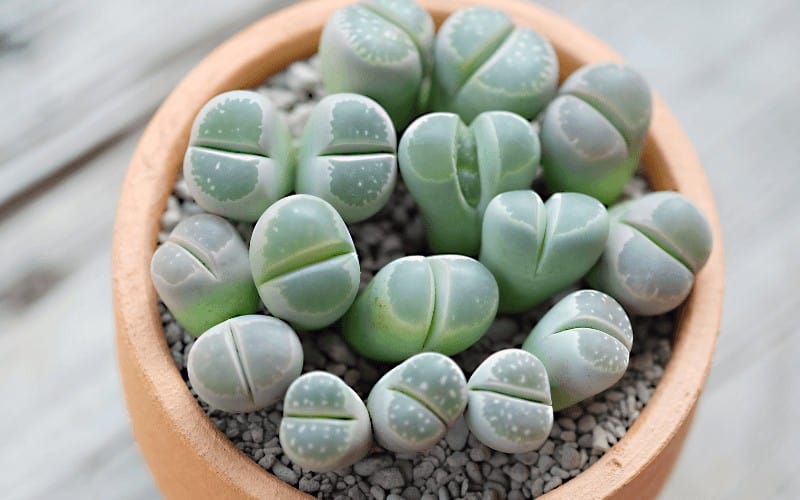
This olive-green living stone is a small succulent plant with bodies of two opposite partly fused leaves. It was collected by Mr. E. R. Fuller in 1928 near Kakamus in the Kenhardt district.
This type of lithops grows 25mm long and 18mm wide. It has large clumps, often from 30 to more heads, it bears olive-green or grayish-green. It grows on quartz plains.
15. Lithops Werneri
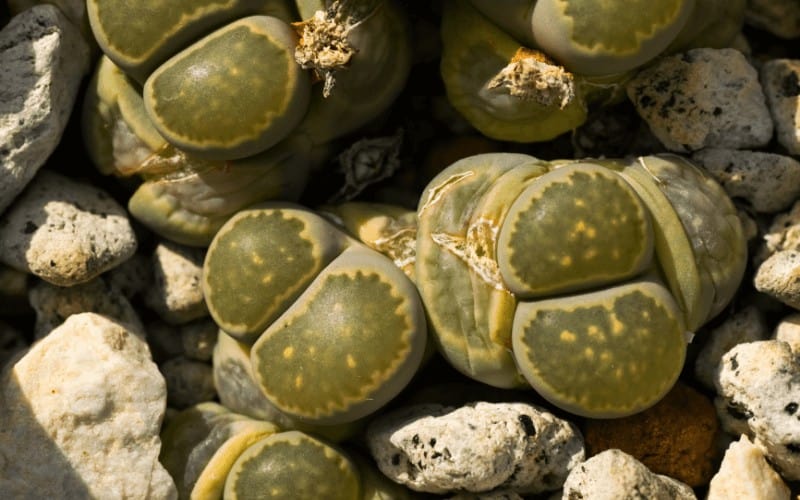
Also called werner's living stone is from the family of Aizoacea. Though it was described by Schwantes H. Jacobsen in 1951. It was collected by Mr. Werner Trieber and named in his honor.
It is mostly found in Namibia where lithops are nicknamed ‘cattle hoof', ‘sheep hoof,’ and ‘horse hoof' because it resembles hoof prints.
Its natural habitat is rocky areas and grows 20mm long and 15mm wide. It forms large clumps in pots.
Where Can I Find The Right Species Of Lithops?
Earlier in this guide, it was stated that most of the species are found in remote areas and these areas are oftentimes restricted, however, thanks to the development you can easily spot the lithops you can work with in-plant stores.
These days, you can even order through online stores.
Recognizing the right species might be somewhat difficult because they all seemingly look alike and can only be differentiated by the shape, color, and texture of the plant.
Hopefully, you find it, and if you have - here are some procedures for caring for your lithops plant.
How to Grow and Care For Lithops
Lithops would do well according to the place it is situated. Some species from Namaqualand and southwest Africa grow in very arid areas which often receive less than 125mm of rain a year.
Lithops that have their origin from the Transvaal and Orange Free State, grows in any area that has high annual rainfall.
Planting, potting, and repotting lithops
When planting, try placing the plant slightly above the soil surface. You can surround the surface with stone or pebbles to give it a natural appearance - remember it is a stone plant.
When potting lithops, use a larger pot than the plant because it has an extensive root system. Preferably a pot 3-6 inches deep, with drain holes - this is to give the plant chance to grow without discomfort.
When to Plant Lithops
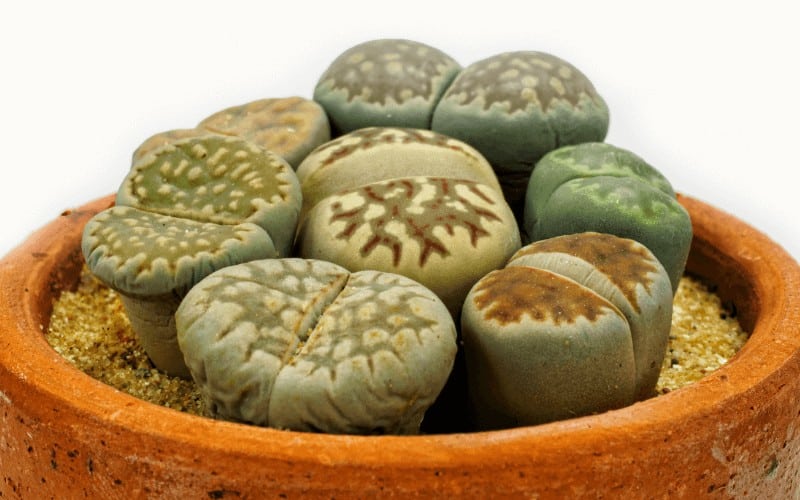
It is best to Plant the lithops seeds during summer in a sandy medium and cover it with a thin layer of fine sand. Afterwards, water the seeds gently and you can transplant them when they are a year older.
In some parts of Europe, it is best to sow lithops seedlings between September to October. Other places would require it to be down at the end of the normal growing season.
Note: it is most preferably as a houseplant; planted indoors or outdoors
Here are some tips for planting and reporting lithops:
- Try to plant or report lithops during a growing season (spring or autumn) and water them after replanting. If you do wish to water regularly then replant during (summer or winter) because they are mostly dormant during this season and watering would kill them.
- During early autumn, lithops would resume growth. When you notice the bud is out, then it’s a sign that new life has sprout within the lithops.
- Additionally, while lithops would do well in rocks, it does great in rich soils too.
Here is a suitable soil mixture for the seed sowing. They might prefer coarse sand or grit so that the mixture is porous.
- Use a mixture of ½ part coarse sand or grit
- ¼ part medium grade peat
- ¼ part garden soil
You can also use a special cactus potting mix, for best result use sandy loam that is slightly acidic in reaction. It might not like silver because of the lime content.
Positioning
Place the container in a warm sunny spot. Ensure to keep them moist but not soggy and then the first seeds would germinate within a few weeks.
Watering Lithops
Your lithops plant can do very without watering for some certain period. Though it has no stem, only taproots that merge at the base of the leaves. The thick leaves can transport the stored water needed to keep the plant alive.
Watering lithops might differ from species but all its kind does not accommodate overwatering or underwatering.
While overwatering causes early dismissal of the plant and brings about rot which would prompt the plant to produce new bodies at the wrong time of the season; underwatering causes stunted growth.
Tips for watering lithops:
- Water your plant when it is wrinkled, it restores the firm appearance of your plant. Water in later summer to early fall, more often but do not overwater. It is best to water until about the top one-half inch of the soil is moistened.
- As soon as your plant becomes dormant during summer don’t water the plant anymore.
- Let your plant dry out during winter and spring this is because the humidity would suffice. The old plant should be left to dry out to give room for the new life to bloom.
- Once the seedlings start to develop, reduce watering.
Note: Overwatering the seedlings may cause damping. When it starts growing, at most 3-4 months, let them dry completely for some days before watering again.
- When the plant is regenerating avoid watering the plant as the new plant gets the necessary nutrients from the old plant and watering it automatically gives strength to the old plant and this confuses the new plant; this might lead to them both dying.
Light requirement for lithops
Lithops like indirect sunlight though they can receive 4-5 hours of direct sunlight during early hours and partial shade during the afternoon. If exposed to poor or too much light your plant might suffer from etiolation.
If you are bringing the seeds newly, do not introduce them to bright sunlight immediately, rather put them in an area with less direct sun.
Note: proper lighting maintains the vibrant color of succulent.
Improper lighting causes the plant too;
- Loss of coloration and turn greenish
- Lean to one side in search of light
- Grow inappropriately
- Eventually, die if not taken care of
Temperature
The lithops plant can tolerate very high temperatures, provided it is exposed to plenty of fresh air.
Humidity
The lithops plant thrives in low humidity, in other words, do not leave it in cold areas for long.
Fertilizing
Fertilize your lithops using a fertilizer that is low in nitrogen and high in potassium.
Propagation
This loving plant make propagating easy, oftentimes it shoots out seeds, since the flowers are daisies alike, during autumn the flowers open up to splash out new seeds with this you can cross-pollinate.
More so, when flowers die they leave out pods that are made open when the flour is moistened, collect the seeds. The plant will close back to protect its seed and reopens when moistened again.
Flowering
Lithops may produce flowers during spring and early winter, possessing several colors, these flowers in the afternoon and closes in the evening.
After flowering, it goes into a period of dormancy, the old plant will give room for the old plant to grow; the old plant will usually wear off during spring.
Pruning
Lithops do not require pruning unless they look messy.
Pests/insects attack
Lithops are likely to be attacked by pests such as; scale, mealybugs, thrips, aphids, snails, and slugs, root-knot nematodes, mice.
Pest control
You can remove mealybugs and scale using cotton dipped in alcohol. You can use an alcohol solution to wipe invisible pests, but you have to be careful, it might damage the plant. You can use Apple Cider Vinegar also.
While snails might seem unharmful, the key is to keep the plant attractive. Keep mice at bay with traps add carrots to the trap.
Use insecticides like prophylactic treatment to kill aphids. Though spider invites might thrive in hot weather, it doesn’t like humidity. You might want to know the signs of a dying lithops.
In truth, lithops species might seem uncountable because of their wide range. However, this loving plant can be beneficial as it has been proven to be non-toxic to humans and pets and it is edible in some places in Africa
Frequently Asked Questions
How many different types of Lithops are there?
Lithops comes in about 37 species and about 145+ varieties with new species being discovered every time.
How do I know what Lithop I have?
Lithops typically look alike, but you can know the species you have mainly by its shape, color, markings, and body texture.
Do Lithops multiply?
Yes, lithops naturally multiply whenever they split into two new halves.
Are Lithops rare?
Yes, lithops are somewhat rare and hard to find in nurseries as their seed can take about one year to germinate and they require carefully controlled conditions to thrive.
Are Lithops colorful?
Yes, lithops produces flowers in different colors, such as orange, white, red, and yellow.
Can Lithops grow indoors?
Yes, lithops are a fantastic addition to an indoor succulent garden or rock garden. You can grow lithops indoors in a sunny spot like a window sill.
Do Lithops die after flowering?
Yes, Lithops will go into dormant for a while after they flowers, this enables them to prepare for the new growth.
Why are my Lithops so tall?
Basically, Lithops becomes pale and grow taller when they aren’t getting enough light.
How often do you water Lithops?
During its growth period in warmer months, water Lithops plant once every two weeks. Living stone plant like frequent watering during late spring and summer; however, you may have to water it occasionally during the winter.
How long does it take for lithops to split?
It can take about one or two months for lithops to split, depending on conditions.
Why do Lithops look like stones?
Lithops look like stones because they’re mostly found in arid, rocky areas, which is why they camouflaged as stones to protect themselves against wandering herbivores.
You may also like the following post:
- Types of Ginkgo Trees
- Types of Calathea Plants
- Types of Palm Trees
- Types of Snowball Bushes
- Dieffenbachia Plant Care
Conclusion | Lithops Varieties
These are some of the most popular types of lithops. They are good plants if you are considering a house plant that you have to pay minimal attention to its care.
All they just need is to be under the sun and some water once in a while. Lithops are quite attractive, they produce leaves every year. The leaves grow from the slit in between aged leaves.
Your lithops only get new flowers yearly, it does not get bigger, so you have the lithops in a particular pot for years without needing to change the pot. Considering getting a house plant? Why not get a living stone today?




